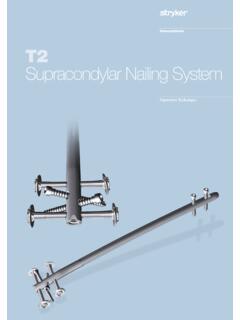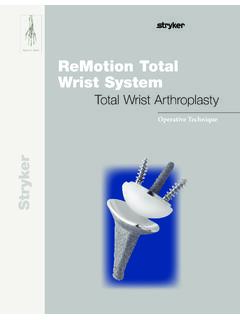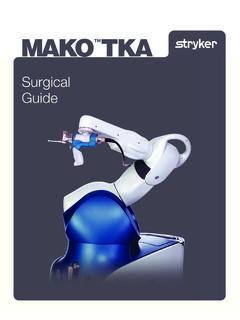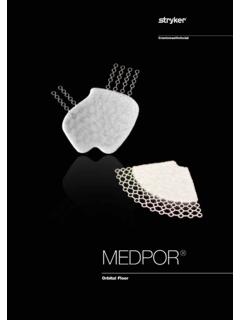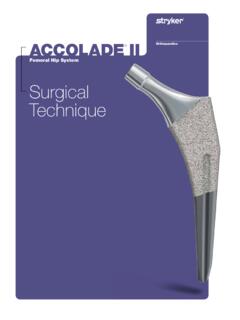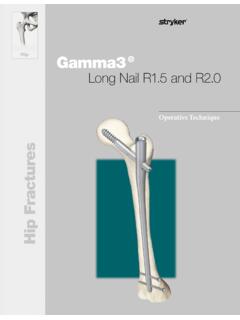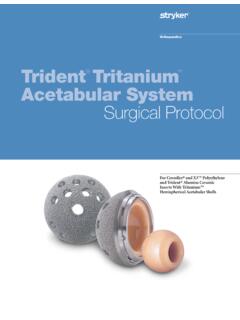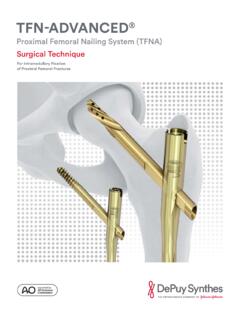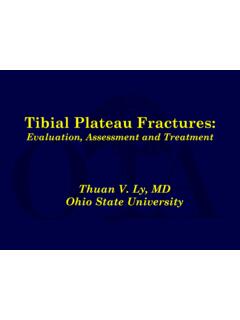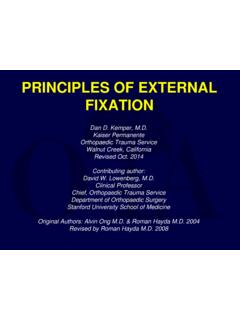Transcription of RMOD-SP-8 2013 1588 LRMCBC ST rmod-sp-1 5
1 RESTORATION MODULAR REVISION HIP SYSTEMS urgicalTechniqueRestoration Modular Cone Body/Conical Distal Stem Femoral Components Using the Restoration Modular Instrument SystemRestoration ModularRevision Hip SystemRestoration Modular Revision Hip System Surgical ProtocolIndications Noninflammatory degenerative joint disease, including osteoarthritis and avascular necrosis; Rheumatoid arthritis; Correction of functional deformity; Revision procedures where other treatments or devices have failed; and, Nonunions, femoral neck fractures, and trochanteric fractures of the proximal femur with head involvement that are unmanageable using other techniques.
2 The Restoration Modular Hip System is intended for primary and revision total hip arthroplasty as well as in the presence of severe proximal bone loss. These femoral stems are designed to be press fit into the proximal Active infection or suspected latent infection in or about the hip joint; Bone stock that is inadequate for support or fixation of the prosthesis; Skeletal immaturity; Any mental or neuromuscular disorder that would create an unacceptable risk of prosthesis instability, prosthesis fixation failure, or complications in postoperative care.
3 See package insert for warnings, precautions, adverse effects, information for patients and other essential product information. Before using Restoration Modular instrumentation, verify: Instruments have been properly disassembled prior to cleaning and sterilization; Instruments have been properly assembled post-sterilization; Instruments have maintained design integrity; and, Proper size configurations are instructions for Cleaning, Sterilization, Inspection and Maintenance of Orthopaedic Medical Devices, refer to Modular Cone Body/Conical Distal Stem Femoral Components Using the Restoration Modular Instrument SystemAcetabular OptionsStryker Orthopaedics offers a wide variety of acetabular components that are compatible with the Restoration Modular Femoral Components.
4 The surgeon should refer to a specific acetabular component s surgical technique for a discussion of acetabular surgical procedures. The Restoration Modular Hip System is compatible only with Stryker Orthopaedics femoral bearing heads listed in the chart on page 16 and page publication sets forth recommended procedures for using Stryker Orthopaedics devices and instruments. It offers guidance that you should heed, but, as with any such technical guide, each surgeon must consider the particular needs of each patient and make appropriate adjustments when and as ModularSurgical Protocol D Antonio, J.
5 , et al., Classification of Femoral Abnormalities in Total Hip Arthroplasty. Clin Ortho and Rel Research. 1993; Number 296: pp. 133 139. Longjohn, D. & Dorr, L. Bone Stock Loss and Allografting: Femur. Revision Total Hip Arthroplasty. 1999. pp. 100 111.* Capello WN, D Antonio JA, Feinberg JR, et al., Hydroxyapatite in Total Hip Arthroplasty. Clinical Results and Critical issues, corp, 1998; Number 355: pp. 200 - OverviewThe Modular Cone Body/Conical Distal Stem Femoral components are part of the Restoration Modular Revision Hip System. The system takes advantage of the long clinical experience with distally fixed implants, while making use of modern technology to enhance proximal load transfer to the femur.
6 This is achieved by mating a selected proximal body with a selected distal stem to provide a femoral prosthesis that minimizes proximal-distal mismatching, often associated with monolithic hip surgery is very complex in that the surgeon may face compromised soft tissues, retained cement, severe bone loss, and poor residual bone. A set of implant options is essential to best fit the implant to the present bone defect. The Restoration Modular Cone Body/Conical Distal Stem Femoral Components were designed specifically for use in revision cases in which the femoral bone stock is severely compromised in the proximal third or proximal half of the femur.
7 They also may be used for less challenging reconstructive surgery ranging from difficult primaries up to and including Type III revision cases. The titanium alloy (Ti-6Al-4V ELI) Cone Bodies are circumferentially plasma sprayed with commercially pure titanium and then over-sprayed with PureFix HA. These surface enhancements have demonstrated biocompatibility through many years of use at Stryker Orthopaedics.* Proximally, the Cone Body segment helps maintain rotational and axial stability when adjacent to viable bone. Seven Cone Body diameters are available (range 19mm through 31mm in 2mm increments) with four vertical offsets: +0mm (STD), +10mm, +20mm, and +30mm.
8 These vertical offsets may be used to adjust overall stem length intraoperatively. (See Sizing Charts on page 3.)Cone Bodies incorporate a V40 taper and are compatible with CoCr, Biolox delta Ceramic and Alumina Ceramic Femoral Conical Distal Stem is designed to provide immediate diaphyseal rotational and axial stability. These stems are available in three lengths 155mm, 195mm, and 235mm. Each distal stem length comes in 15 fluted, conical diameters from 14mm to 28mm in 1mm increments. The 155mm and 195mm Conical Distal Stems are offered with a straight design option.
9 The 195mm Conical Distal Stem is also offered with a bowed option. The 235mm Conical Distal Stem is only offered with a bowed option. The total length of the Cone Body/Conical Distal Stem construct will be dependent upon the body and stem chosen. Standard stem lengths are measured from the +0mm (STD) Cone Body with a +0mm (STD) Femoral Head from the head center to the distal tip of each of the three lengths of Conical Distal Stems. Review Sizing Charts for stem lengths on page 3. Note: The Cone Body/Conical Distal Stem lengths are measured using the +0mm (STD) Cone Body with a +0mm (STD) Femoral Head from the head center to the distal tip of the Conical Distal ModularSurgical ProtocolCone Body Sizes and Head Offsets with V40 Femoral Heads available in 22mm, 26mm, 28mm, 32mm, 36mm, 40mm & 44mmStem Length Options Cone Distal Distal Body Neck Stem Lengths Stem Sizes Angle (mm)
10 Diameters 19mm 21mm 23mm 14mm 28mm 25mm 132 155, 195, 235 in 1mm 27mm Increments 29mm 31mm *Not available in 22mm or 26mm diameter head (see Head Compatibility chart on pages 16 or 19). 155mm Length 14mm-28mm dia. 225mm 235mm 245mm 255mm (Straight) 195mm Length 14mm-28mm dia. 265mm 275mm 285mm 295mm (Straight & Bowed) 235mm Length 14mm-28mm dia. 305mm 315mm 325mm 335mm (Bowed)Conical Distal Stem SizesCone Body Heights** Femoral head neck length options will increase overall stem lengths range -4mm, +0mm (STD), +4mm, +8mm, and +12mm.
